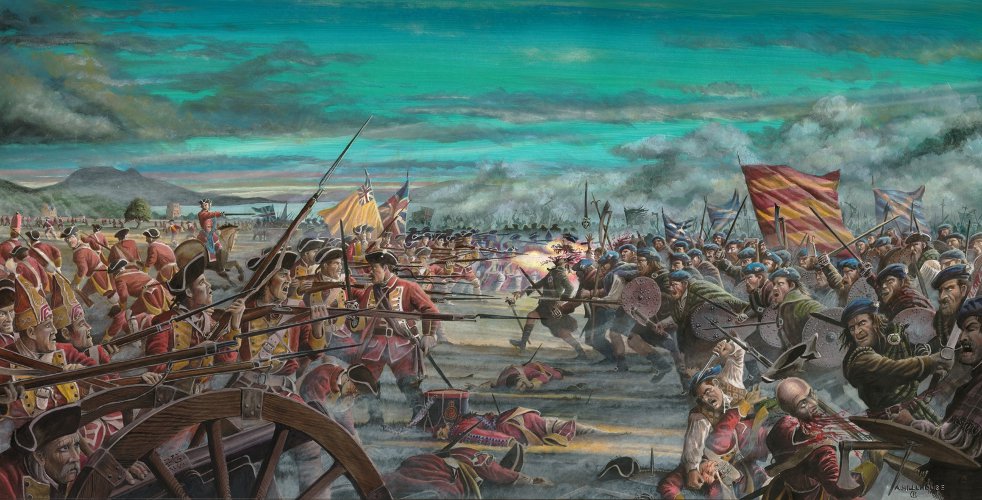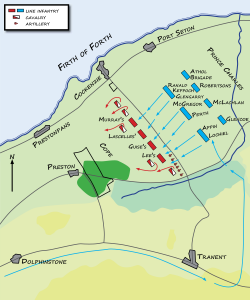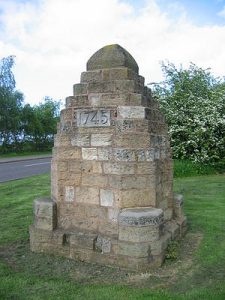
Over 270 years ago, a mere 12 miles from Edinburgh, one of the first and arguably one of the most important battles of the Jacobite Rising of 1745 took place. It was the first step in a campaign to place a Stuart back on the British throne.
In the early half of 1745, Charles Edward Stuart or Bonnie Prince Charlie, saw an opportunity to reclaim what he considered to be his father’s two kingdoms, Great Britain, formally united in 1707, and Ireland. George II and the British army were occupied in the War of the Austrian Succession, leaving only around 6,000 troops to defend England. Aided by the early support of Donald Cameron of Lochiel, XIX chief of Clan Cameron, he and is party of men were successful in raising a force of 2,000 Scots.
With word of this force ready to march on the Lowlands, it was up to Sir John Cope to give a response root he government. Cope was the general in command of the 4,000 government troops stationed in Scotland, but unfortunately the most of his troops were only recently raised and as a result inexperienced. Cope and his troops marched on Fort Augustus in the heart of the Highlands in an effort to awe the Highlanders into surrender and end the rebellion before it had truly begun. Upon hearing that the rebel army was looking to oppose him at Corryarrack, he instead marched to Inverness hoping to be the one to decide the battleground. Cope had underestimated the men commanding the rebel forces.
Bonnie Prince Charlie and his troops marched straight down to the Lowlands, which by now were almost undefended. A small force which held Edinburgh retreated in the face of the superior foe, leaving the city open for the taking. On 16 September, some of Prince Charles’s army captured the city with little or no fighting, though Edinburgh Castle was still defended for the government. Cope meanwhile furiously marched to Aberdeen are he had urgently ordered ships, so he and his troops could make haste o the south. On the same day the Jacobites took Edinburgh, Cope and his men disembarked in Dunbar.
Even though Cope knew his troops were far from the best, he was determined to engage the Jacobite force. His intelligence told him that the rebels only numbered around 2,000 men, and whilst they were fit and hardy, they were ill-equipped. Cope believed this would mean his force, in two regiments of dragoons and three and a half regiments of infantry, should easily overpower them. It was even said that on their march towards Edinburgh they assured the locals that there would be no battle.
It was on the 20th of September that the two forces first met, just outside Prestonpans near Preston house. The Jacobite army had secured the high ground to the south of Cope’s position, but Cope was determined to face the rebels and made the best of his situation. He drew up his force facing south using the park walls of Preston house to provide protection for the right flank and a marshy bog to the front. Although they had secured a good position the Jacobites were dismayed by the way Cope had taken advantage of the land. A traditional Highland charge would flounder in the marshes and be decimated by musket and cannon fire. The senior Jacobite officers knew they must change their plans if they were to come away victorious but could not agree on what should be done. It was Lord George Murray who pushed for them to move their force to the East so they could assault the exposed left flank of the government forces and it was Lieutenant Anderson, a local farmers son, who knew the lay of the land and knew of a way to get the force where it needed to go. At 4am on the 21st the Jacobites began to move, 3 abreast along a narrow defile, in order to reach the east flank.
 Meanwhile, Cope had noticed some movement in the opposing force juts before dark, though this move was the result of confusion in the Jacobite ranks and was abandoned. He feared that the Jacobite planned to attack both his flanks and thus redeployed in forces in a north south front, the formation that they would fight in the next day. He also ordered that 200 dragoons and 300 infantryman should take on picket duty and light fires in the front of his position in order to thwart any plans for a surprise night attack. Cope felt secure with these measures and in addition ordered 3 companies of Louden’s Highlanders to guard the baggage park in Cockenzie, as well as dismissing some 100 volunteers ordering them to report back in the morning. Cope also made a last minute attempt to gain reinforcements from Edinburgh Castle, requesting Artilleryman to attend his position. It would be for nought though, as the battle would take place a lot earlier than Cope had expected.
Meanwhile, Cope had noticed some movement in the opposing force juts before dark, though this move was the result of confusion in the Jacobite ranks and was abandoned. He feared that the Jacobite planned to attack both his flanks and thus redeployed in forces in a north south front, the formation that they would fight in the next day. He also ordered that 200 dragoons and 300 infantryman should take on picket duty and light fires in the front of his position in order to thwart any plans for a surprise night attack. Cope felt secure with these measures and in addition ordered 3 companies of Louden’s Highlanders to guard the baggage park in Cockenzie, as well as dismissing some 100 volunteers ordering them to report back in the morning. Cope also made a last minute attempt to gain reinforcements from Edinburgh Castle, requesting Artilleryman to attend his position. It would be for nought though, as the battle would take place a lot earlier than Cope had expected.
At the crack of dawn on the 21st September, Cope’s Dragoons beheld a spectacle that would send a shiver down any sane mans spine. Out of the early morning mist, making “wild Highland war cries and with the bloodcurdling skirl of the pipes” came 1,400 Highlanders charging straight towards Cope and his men. Cope’s inexperienced army wheeled to meet a foe they were not expecting to come from the east, and Cope even managed to scramble some artillery into position. Undaunted by the light and inaccurate fire the Highlanders continued their charge. The centre of this charge became bogged down in an are of marshland, which meant the straight line of the charge became a v formation. The wings on either side met with the dragoons on either side of the British force, which caused them to immediately flee.
This meant that Cope was left with only the centre of his force, which also happened to be the experienced Royal Infantry. Unfortunately for hem the unplanned flanking manoeuvre by the Jacobites, which happened when the wings of the v wrapped around the side of the Royal Infantry and the centre met them head on, meant the were effectively surrounded by Highlanders and they suffered for it. After sustaining heavy casualties they eventually gave way.
Around 10 minutes after the battle had begun, it was over. Hundreds of government troops were dead or injured, and thousands were taken prisoner whom Bonnie Prince Charlie himself ordered should be treated with the greatest of care. The Jacobite’s on the other hand had only suffered around 100 casualties. Cope still in charge of around 200 men, pulled them away to reorganise and rally them in an adjacent field, but they refused to engage the enemy further. Cope had no choice but to retreat and make the long journey south to the relative safety of Berwick-upon-tweed.
Cope’s baggage train in Cockenzie was seized giving the Jacobites around £5000, many muskets and plenty of ammunition but this was not all the victory gave to the cause. It signalled the true beginning of the rebellion, greatly boosting the morale of the Stuart supporters, and causing a surge in recruitment to the Jacobites in Scotland. The battle cemented the seriousness of this new Jacobite rebellion and it’s effectiveness to claim victory in the battles to come.
 A cairn was erected in 1953 to commemorate the memory of all those that fell in the battle. A coal bing was also erected, atop which flies Prince Charlie’s battle flag, using the remains of the area’s coal shale shaped into an obelisk to provide a vantage point for today’s visitors.
A cairn was erected in 1953 to commemorate the memory of all those that fell in the battle. A coal bing was also erected, atop which flies Prince Charlie’s battle flag, using the remains of the area’s coal shale shaped into an obelisk to provide a vantage point for today’s visitors.
In 2006 the Battle of Prestonpans 1745 Heritage Trust was established with the goal to ensure much better presentation and interpretation of the battle. Plans include a visitor Centre in the grounds of Prestongrange Industrial Heritage Museum, ‘Living History’ battle re-enactments, battle-related storytelling and new novels, and a new ‘Flowering of the Arts’ including embroidery.
In 2008 the Trust commissioned Glasgow University Archaeological Research Division to undertake a comprehensive survey, followed by selective excavation, of the battlefield. Although it was thought that the location of the battlefield was known for years the team actually discovered that the true site was located some 500 yards away. Based on concentrations of musket balls and other evidence, this new site is where it is believed the Highlanders charge actually took place.
Details of all the Trust’s activities can be found at its website – www.battleofprestonpans1745.org
